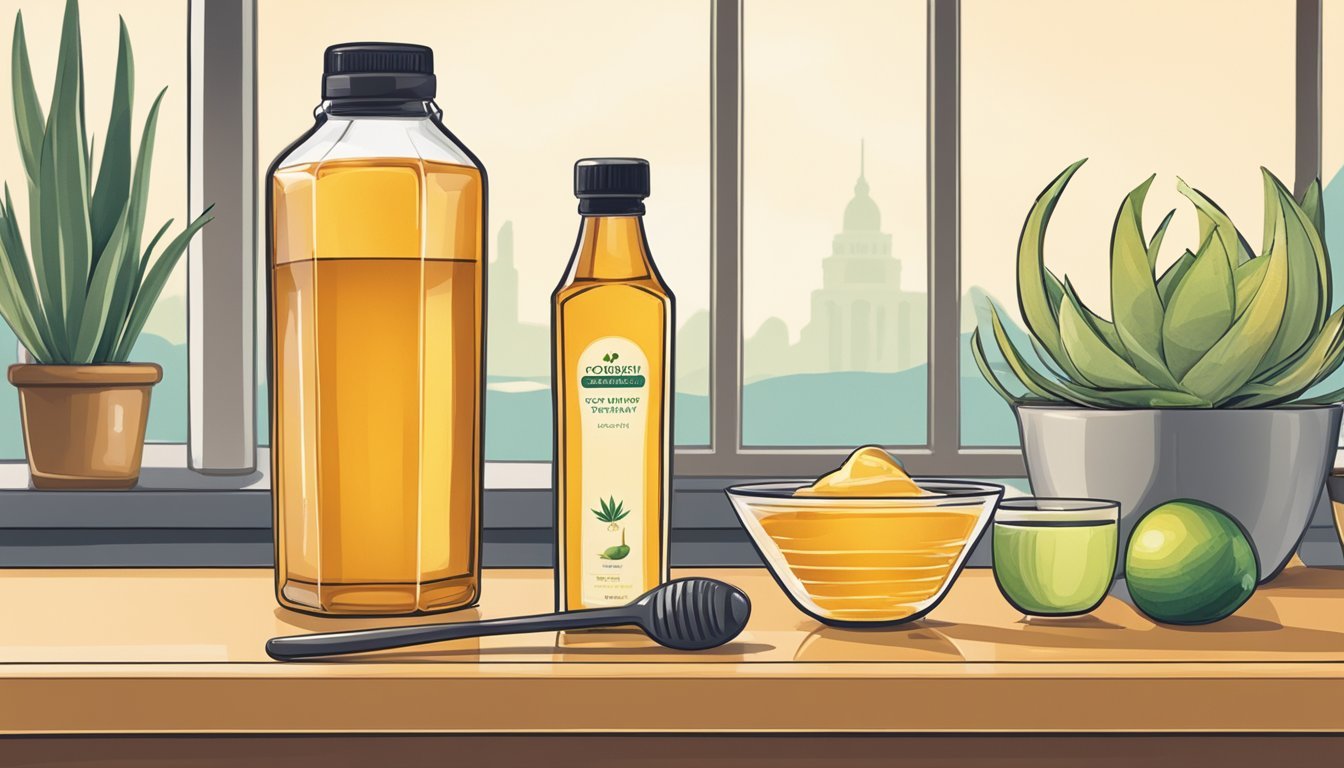How to Substitute Honey for Agave Nectar
Simple Swap Guide
When looking for natural sweeteners as alternatives to refined sugars, honey (What wine goes well with honey?) and agave nectar are two popular options that many people consider. Agave nectar, derived from the blue agave plant, is a sweetener commonly used in baking and as a syrup for pancakes and waffles. It has a fluid consistency and a sweetness that's comparable to honey. For those who prefer the taste or health benefits of honey, substituting it for agave nectar is a straightforward process.
Honey is a natural sweetener produced by bees and is valued not only for its sweetness but also for its nuanced flavor profile, which varies depending on the flowers visited by the bees. It's often praised for its antioxidant properties and can serve as a one-to-one substitute for agave nectar in many recipes. However, because honey has a denser texture and slightly higher sweetness intensity compared to agave, some minor adjustments to recipes are beneficial for optimal results.
The substitution of honey for agave nectar involves simple ratio adjustments and minor modifications to liquids and sugars present in the original recipe. To maintain the desired texture and flavor balance, it's recommended to slightly reduce other sources of liquid and sugar when incorporating honey. This ensures the end product retains its intended taste and consistency, even with the substitution of sweeteners.
Understanding Agave and Honey
Agave and honey are both natural sweeteners derived from plant sources. Agave nectar comes from the sap of the blue agave plant, commonly found in Mexico. The sap is heated to break down its carbohydrates into sugars. The primary sugar in agave nectar is fructose, which is responsible for its lower glycemic index when compared to honey; this makes it a popular choice among those looking to manage blood sugar levels.
Honey, on the other hand, is a sweet substance produced by bees from the nectar of flowers. Honey's composition is more diverse, including sugars such as glucose, fructose, maltose, and sucrose. It is also higher in calories and carbohydrates than agave nectar. Honey boasts a variety of antioxidants, phytochemicals, and trace amounts of vitamins and minerals. In terms of flavor, honey's taste can vary based on the flowers from which bees collect the nectar.
In terms of sweetness, agave is generally considered sweeter than honey, which means less may be required to achieve the same level of sweetness in recipes. For those adhering to a vegan lifestyle, agave nectar serves as a plant-based substitute due to ethical considerations regarding bee products.
Here is a brief comparison:
Feature Agave Nectar Honey Source Blue agave plant sap Nectar of flowers collected by bees Glycemic Index Lower (due to higher fructose content) Higher Sweetness Sweeter (less required for similar sweetness) Varies based on flower source Calories Fewer per tablespoon More per tablespoon Composition Primarily fructose Glucose, fructose, galactose, maltose, sucrose Suitable for Vegans Yes No (as it is an animal byproduct) Nutritional Components Minimal; trace vitamins and minerals Antioxidants, trace vitamins, minerals, phytochemicals
Agave and honey offer varying nutritional profiles and culinary applications. Consumers often choose between them based on dietary needs, taste preference, and lifestyle considerations such as veganism.
Substituting Honey for Agave Nectar in Recipes
When one opts to substitute honey for agave nectar in various types of recipes, such as baking, cooking, desserts, dressings, margaritas, marinades, and sauces, it's important to consider the sweetness and texture implications. Honey, which is slightly richer and thicker than agave nectar, imparts a distinct floral flavor profile that one should take into account before making a direct substitution.
In baking, one can replace agave nectar with an equivalent amount of honey. However, due to honey's higher density, adjustments might be necessary:
Liquid Ratio: Decrease other liquids in the recipe by about 1/4 cup for every cup of honey used to balance the moisture content.
Sugar Content: Lower the added sugar by approximately 1 tablespoon for every cup of honey because of its inherent sweetness.
For desserts and sauces, the viscosity of honey can be an advantage, offering thicker texture. On the other hand, in dressings and marinades, honey will combine differently due to its thickness. It's recommended to whisk or blend thoroughly to achieve a homogenous consistency.
When making a margarita, the bartender may have to consider honey's tendency not to dissolve well in cold liquids. Gentle heating of honey before adding it can help, but one should also ensure that the unique taste of honey complements the cocktail.
Here's a simplified guideline chart for honey substitution:
Agave Nectar Honey Adjustments Needed 1 cup 1 cup Decrease liquid by 1/4 cup, reduce added sugar by 1 tbsp 1 tbsp 1 tbsp None
Considering these alterations will help maintain the balance of flavors and textures within recipes.
Baking with Honey and Agave Nectar
When substituting honey for agave nectar in baking, precise adjustments are essential to maintain desired sweetness, moisture, and bake times. Each type of sweetener contributes distinct features that can significantly affect the outcome of baked goods.
Adjusting Sweetness Levels
Honey is typically sweeter than agave nectar due to its higher sugar content. A direct one-to-one substitution may result in overly sweet baked goods. To mitigate this, bakers should start by using less honey—about three-quarters of the amount of agave originally called for and adjust to taste from there.
Adapting Liquid Content
Honey has a thicker consistency compared to the more syrup-like agave nectar. This difference necessitates altering the liquid ingredients in a recipe. If using honey in place of agave, reduce other liquids by approximately one-fourth of a cup for every one cup of honey added to prevent the batter from being too wet.
Considering Bake Times
Items baked with honey may brown more quickly due to the natural sugars caramelizing. Therefore, it is advisable to:
Monitor baked goods closely and reduce oven temperatures by about 25°F.
Check for doneness slightly earlier than when using agave to avoid over-browning.
Selecting the Right Honey
Not all honey is the same; variations in color and flavor exist, from clover to wildflower to buckwheat. For substitutions, it is best to use a lighter-colored honey, as it more closely resembles the mild flavor of agave nectar and will not overpower other ingredients. Darker honeys, like molasses, have a robust taste and may alter the intended flavor profile of the recipe.
Health and Nutritional Comparison
When substituting honey for agave nectar, it is pivotal to understand their health and nutritional variances. Calories differ slightly: agave nectar contains approximately 60 calories per tablespoon, while honey typically contains 64 calories. However, because agave nectar is generally sweeter, one might use less, potentially reducing caloric intake.
Fructose content is another significant factor. Agave nectar has a higher fructose content than honey, which may impact blood sugar levels. People with diabetes or those monitoring their blood sugar might prefer agave for its low glycemic index. The glycemic index for agave nectar is considerably lower than honey, which could help prevent spikes in blood sugar levels.
Nutrient profile is an essential consideration as both are not particularly nutrient-rich; however, honey contains modest amounts of vitamins and antioxidants. These beneficial compounds can contribute to the anti-inflammatory properties linked with honey.
Sweetener Glycemic Index Calories Fructose Content Agave Nectar Low ~60 High Honey Medium ~64 Moderate
In conclusion, while both can contribute to weight gain and obesity if consumed in excess, they can still be part of a balanced diet. One should note the higher fructose content in agave nectar compared to honey, which may influence individual health outcomes differently. Choosing between the two sweeteners should consider both their health implications and the specific dietary needs of an individual.
Substitutes for Agave Nectar and Honey
When replacing agave nectar or honey in recipes, there are several alternatives that one can consider. Each substitute has its own unique properties and may be more appropriate for certain types of dishes.
Liquid Sweeteners
For a liquid sweetener similar in consistency and sweetness to agave nectar and honey, consider the following:
Maple Syrup: Offers a distinctive flavor ideal for pancakes, waffles, and baking. Use a 1:1 ratio.
Corn Syrup: Suitable for candy making and recipes that require a sweetener less likely to crystallize. Light corn syrup is best used at a 1:1 ratio.
Brown Rice Syrup: Works well in granola bars and baking, with a 1:1 ratio for agave, though slightly less sweet.
Coconut Nectar: A less processed option, it has a similar sweetness and can be substituted equally for agave nectar.
Dry and Less Processed Sweeteners
For those who prefer a less processed or dry sweetener, consider these options:
Sugar: While less complex in flavor, it’s readily available and can be used in a pinch. Start with 3/4 cup of sugar for each cup of agave, adjusting to taste.
Stevia: Much sweeter than agave or honey, stevia should be used sparingly. Read package instructions for proper substitution ratios.
Homemade Simple Syrup
One can create their own simple syrup by dissolving equal parts sugar and water, providing versatility for both cooking and beverage sweetening.
To ensure the best results when substituting, one should consider the recipe and desired outcome, as changes in sweetener types can impact both the flavor and texture of the final dish.
Usage in Beverages and Cocktails
When substituting honey for agave nectar in beverages and cocktails, individuals should consider the sweetness level and flavor profile. Agave nectar carries a lighter taste, whereas honey has a more pronounced flavor that can alter the profile of the drink.
Beverages:
Teas: Honey dissolves well and adds a floral hint. Use a less amount as it's sweeter than agave.
Coffee: It provides a smooth assimilation. Start with half the amount usually used for agave.
Cocktails:
Margarita: Replace agave with honey syrup—mix honey with equal parts of water to ensure proper blending.
Other Mixed Drinks: Utilize honey as a natural sweetener. Balance with other ingredients as needed.
Quantities (general guide):
Agave Nectar Honey Notes 1 tsp 1/2 tsp Adjust according to taste. 1 tbsp 1/2 - 3/4 tbsp Honey's flavor is stronger. 1 cup 3/4 cup For large quantities, the difference is notable.
It's crucial to taste and adjust as they go. Both sweeteners are natural choices, but the difference in sugar composition—fructose in agave and glucose, fructose, maltose among others in honey—can affect the sweetness perception and the drink's balance. In recipes originally crafted with agave, the replacement may invite a change not only in sweetness but also in complexity. For a consistent texture in cold beverages, consider creating a simple honey syrup to aid in integration.
Vegan Considerations and Alternatives
For individuals adhering to a vegan diet, finding suitable alternatives to honey is essential, as honey is an animal-derived product. Vegans frequently seek out plant-based natural sweeteners that align with their ethical and dietary choices. Agave nectar is a prominent choice among these alternatives due to its similar sweetness profile and easy substitution ratio.
Agave nectar, sourced from the agave plant, serves as a versatile sweetener. It smoothly integrates into various recipes as a one-for-one swap for honey. This makes it particularly user-friendly for individuals transitioning to vegan sweeteners without the need to adjust measurements.
Maple syrup also stands out as a natural sweetener with its distinct flavor profile. While typically less thick than honey, it can be an excellent addition to a range of culinary applications, from baking to dressing salads.
Below is a quick reference for substituting honey with vegan alternatives:
Honey Quantity Agave Nectar Maple Syrup 1 tablespoon 1 tablespoon 1 tablespoon 1 cup 1 cup 1 cup
Artificial sweeteners are another option for vegans, though they differ significantly from honey and natural sweeteners in terms of composition and taste. Those choosing artificial sweeteners should be mindful of varying sweetness levels and potential aftertastes.
For individuals dedicated to veganism or those with a preference for plant-based sweeteners, options like agave nectar and maple syrup readily provide viable, cruelty-free alternatives to honey. Their ease of use can sweeten the transition to a vegan diet without compromising on flavor or texture.
Culinary Applications Beyond Sweetening
When substituting honey for agave nectar, chefs and home cooks should consider its applications beyond merely sweetening. Honey’s unique properties make it suitable for various culinary uses
In cooking, honey can enhance the flavor profile of a dish. Its rich taste brings a new depth to recipes such as glazed vegetables, adding both sweetness and a slight acidity. Agave nectar, while sweet, does not impart the same complexity.
For dressings, honey acts as both a sweetener and an emulsifier. It helps to balance the acidity in vinaigrettes and can thicken the consistency, which might require adjusting when swapping with agave.
Marinades benefit from honey's natural sugars, which caramelize under heat, adding a delightful glaze to meats and vegetables. To achieve this with agave nectar, one must manage its thinner consistency, which may result in a less pronounced glaze.
When it comes to sauces, honey provides a robust foundation for both sweet and savory variants. Its texture aids in achieving the desired thickness and richness, a characteristic that is notably scant in agave nectar.
Here's how one can substitute honey for agave nectar in different culinary applications:
Agave Nectar Honey Notes 1 cup 1 cup Honey's denser texture may require heating to match agave's fluidity. 1 tbsp 1 tbsp Adjust for honey's stronger flavor; it may overpower delicate dishes.
Remember to consider honey's flavor and texture when substituting it for agave nectar in non-sweetening roles within recipes. Its distinct characteristics can transform a meal's essence.
Procurement and Sustainability of Agave vs. Honey
Agave syrup, also known as agave nectar, is sourced from the sap of the agave plant, specifically the blue agave. The procurement process usually involves cutting and pressing the agave to extract the sap, which is then heated to create a syrupy consistency. It's typically available at both grocery stores and farmer's markets. While the agave nectar is praised for its lower glycemic index, the sustainability aspect is under scrutiny due to the intensive farming practices that can lead to soil erosion and the potential for monoculture crops affecting biodiversity.
On the other hand, honey is a natural product made by bees from the nectar of flowers. Raw honey procurement is reliant on the health of bee populations and their ecosystems. The process of harvesting honey generally has a lower environmental impact compared to agave syrup production. However, bees play a crucial role in the pollination of many plant species, and concerns about bee population declines highlight the importance of sustainable honey production practices.
Product Procurement Sustainability Challenge Agave Syrup Harvested from blue agave plants Soil erosion, monoculture, water use Honey Produced by bees from flower nectar Bee population declines, habitat loss
Both agave nectar and honey are popular sweeteners and consumers often find them side by side in grocery store aisles. It is worth noting that the sustainable sourcing of both products depends on the practices of individual producers. Consumers interested in these aspects should research brands and favor those that commit to ethical and environmentally friendly practices.
Potential Health Risks and Moderation
When substituting honey for agave nectar, one must consider the potential health risks associated with sweeteners and the importance of moderation. Both honey and agave nectar can elicit various health consequences when consumed excessively.
Fructose Content: Agave nectar is high in fructose, which can lead to health issues such as obesity and diabetes if consumed in large quantities. Honey, while also containing fructose, has a more balanced ratio of fructose to glucose.
Agave Nectar: Higher fructose content than honey.
Honey: Contains fructose, but also glucose, galactose, maltose, and sucrose.
Caloric and Nutritional Considerations: Though honey contains more calories per tablespoon than agave nectar, it also offers small amounts of vitamins, minerals, and antioxidants. One must use sweeteners judiciously to avoid excessive caloric intake.
Refined Sugar Alternative: Both honey and agave nectar are often considered as natural alternatives to refined sugar. However, they still contribute to caloric intake and should be used in moderation.
Processed Foods and Additives: Unlike high fructose corn syrup and other sweeteners found in processed foods, honey and agave are less processed. They should still be consumed within dietary limits to maintain a balanced diet.
Dietary Restrictions and Health Conditions: People with certain dietary restrictions or health conditions should opt for sweeteners that align with their dietary needs.
Diabetes: Individuals with diabetes should monitor blood sugar levels as both sweeteners can influence glucose levels.
Triglycerides: High triglyceride levels can be exacerbated by sweeteners high in fructose, cautioning against overuse of agave nectar.
In summary, moderation is key in the consumption of any sweeteners, including when substituting honey for agave nectar. Consumers should be mindful of the potential health risks, especially in the context of a balanced diet and personal health goals.
Exploring Sweetener Alternatives
When substituting honey for agave nectar, one must consider the vast array of sweetener alternatives available, categorizing them into natural sources and processed options to choose an appropriate substitute.
Natural Sources
Natural sweeteners provide a variety of flavors and nutritional profiles, offering more than just sweetness. Honey is an excellent natural substitute for agave nectar because it shares similar consistencies and is less processed than refined sugars. A direct substitution can typically be made, maintaining the recipe’s desired sweetness. Similarly, maple syrup and fruit syrups like those derived from dates or carob can replace agave in a 1:1 ratio while adding their unique flavors.
Coconut sugar, extracted from the sap of the flower bud stem of the coconut palm, is a granular alternative that pairs well with recipes requiring a deeper, caramel flavor. It ranks lower on the glycemic index compared to table sugar, implying a lesser impact on blood sugar levels.
Artificial and Processed Options
Moving towards artificial and processed sweeteners, there exists a spectrum from granulated sugar to high fructose corn syrup and stevia. While white sugar, or table sugar, is widely available and can be substituted for agave, it is more refined and lacks the subtle flavors found in natural sweeteners. It is often advisable to use less granulated sugar than agave due to its higher sweetness intensity.
Artificial sweeteners like stevia, which derive from a natural plant yet undergo processing, offer an option for those monitoring their sugar intake as they provide sweetness without the calories. In the case of liquid sweeteners like high fructose corn syrup, these are often used in processed foods and beverages but can be used in home baking if one seeks a similar consistency to agave nectar. However, they are less recommended due to health considerations and their highly processed nature.
Cultural and Historical Context of Honey and Agave
Honey has been recognized for its significance since ancient civilizations. The Egyptians and Greeks were known to use honey for dietary and medicinal purposes, suggesting its deep-rooted presence in cultural practices and health treatments. Bees, the producers of honey, have been vital to ecosystems and agriculture through pollination, illustrating an environmental importance that transcends their sweet product.
Agave, particularly the blue agave, holds a special place in Mexican tradition and economy, being the primary plant used for the production of tequila. The agave plant, however, has more to offer than just spirits. The sap, also known as agave nectar or raw agave, has been a part of indigenous life for centuries. Its fibers provided materials for textiles, and the nectar served as a sweetener.
Teas, candy, and other sweet goods often incorporate both honey and agave syrup due to their natural sweetness. Agave syrup, especially, has become a popular vegan alternative to honey.
Sweetness Profile
Honey: Sweeter on the palate with floral undertones.
Agave Syrup: Sweeter than sugar with a more neutral flavor.
Usage in Food
Honey: Commonly used in teas, baking, and as a natural sweetener.
Agave Syrup: Preferred in vegan diets; an ideal substitute for honey in many recipes.
The piña, the core of the agave plant, is the source of agave syrup. Through a process of extraction and heating, the concentrated liquid is transformed into a syrupy consistency. While honey has been a historical staple, agave syrup is gaining ground for its versatility and vegan-friendly attribute. Both honey and agave syrup offer unique flavors and cultural significance that enrich culinary traditions worldwide.








